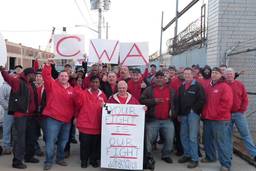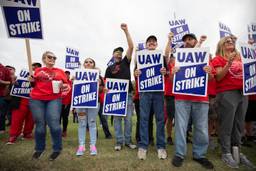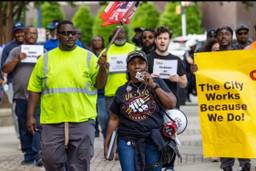A longshoremen struggle and the Huffington Post boycott underscore the importance of carefully escalating labor campaigns
A few months ago, Ezra Klein and I got in an argument about former SEIU labor organizer Stephen Lerner’s idea of a mass strategic default on mortgages, in which many Americans whose mortgages are “underwater” would default on their mortgages in order to hurt big banks and force them to deal with the foreclosure crisis. Klein wrote: “It’s unlikely that the union movement would actually adopt Lerner’s plans, or that they’d even have the power to make good on them if they wanted to adopt them.”
Aside from radical farmers in the Dust Bowl during the 1930s, a strategic mortgage default campaign is practically unheard of in American history. Unions have never tried this, and it would be unlikely they could cause enough defaults to hurt the banks. Unions rarely are successful in significantly hurting the profits of major corporations when they threaten boycotts against corporations. But the threat of a boycott (rather than the actual boycott) can be a powerful tool in forcing a corporate executive to negotiate because of the negative publicity boycotts can produce, and the anxiety an unpredictable corporate campaign of escalation can produce for executives.
In other words, corporate campaigns are often about affecting corporate executives’ psychologically as much as they are about affecting corporate executives economically. As labor journalist Josh Eidelson is fond of saying, “You win in a labor fight when you break the will of an employer to resist.”
The key to that kind of victory, though, is for escalating actions against a corporation to implicitly threaten an ultimate “big action” that wreak havoc on the company. The process of ecalating action should both build support among unionists and the public for such a final action, and make the management so fearful of the action that it decides to concede to workers’ demands.
But many militant unionists prefer to go for the big action right way — as we saw in the struggle of a Longshoreman union local in Longview, Wash., and the attempted boycott of the Huffington Post by the Newspaper Guild and the National Writers Union this year. By employing major confrontational tactics at the start of a struggle, trade unionists risk becoming isolated without any additional way to rachet up pressure if the tactics prove ineffective in breaking the will of an employer to resist.
In Longview, longshoremen have employed a militant campaign of civil disobedience to stop the operation of a recently opened largely nonunion, port. Longshoreman and their families also physically blocked grain trains from entering the port by standing on railway tracks. In July, several hundred longshoremen invaded the port, cut the brake lines to a grain train, and dumped out several tons of grain. 100 longshoremen were arrested.
While the action clearly showed longshoreman were willing to get tough, it also may have undermined their cause. Initial media reports, which remain disputed by longshoremen, suggested the unionists were wielding baseball bats and threatening the physical safety of railroad operators. The company used these reports to seek costly federal injunctions against the union that prevent future actions attempting to block access to the nonunion port. It was very difficult for a judge not to issue a tough injunction against the union in the face of such apparent evidence.
Likewise, it’s difficult to build community support for a union struggle when violence has become involved. While a tough action like busting up a grain train may inspire and harden a hardcore group of union activists, it can also turn off less militant allies in the community, like small businessman and other citizens, who are weary of getting involved in a violent struggle. A lack of violent action and vandalism would have made it easier for the union to argue against tough injunctions against the union in federal court.
Instead of building an escalating corporate campaign of anxiety, the longshoremen deployed their “big threat” of vandalism — and the company has been able to resume their normal operations without problems. The railroad companies responded by hiring armed guards to help them enter the nonunion port. With the armed guards and additional police protection, the trains now enter the port of Longview regularly without problems. The longshoremen in Longview have no way to escalate the campaign.
Similarly, another high-profile labor struggle, unions’ boycott of the Huffington Post (called in March because Huffington doesn’t pay its bloggers, while profiting immensely off of their labor) has floundered. After the sale of Huffington Post to AOL this past March, the Newspaper Guild and National Writers Union called the boycott. (Update: Late on October 20, after this article was published, the Guild and NWU announced they were ending the boycott. But the NWU said it is “continuing and intensifying our Pay The Writer! campaign to establish fair pay rates for freelance journalists working for the Huffington Post and other online publications.”)
Instead of running a massive corporate campaign of leafleting outside of Ariana Huffington’s speaking engagements and lining up supporters among prominent writers of the boycott, the two unions began making good on their big threat of boycotting the website. After the boycott, newspaper guild organizers scrambled to draw up lists of prominent writers supporting the boycott, but still have yet to produce such a list of people in support of the action. Few events or actions have been held to support the boycott, which has largely been ignored by prominent progressives, including several high-profile labor-funded progressives. No deal has been reached between the Huffington Post and the writers union and little support remains for the boycott.
The lesson in all of this is big bold actions are not always the best solution for winning a labor struggle. Even if a union does pull off dramatic actions such as boycotts or civil disobedience that temporarily stops the functioning of a targeted company, as in Longview, the actions may not result in breaking the will of a company to resist. As labor seeks to use the momentum of Occupy Wall Street to take on big corporations, it must remember that bold is not always the best way to beat a corporation — a careful plan of escalation is often crucial.
This post was updated to note that the National Writers Union/UAW Local 1981 ended its boycott of Huffington Post on October 20.

I hope you found this article important. Before you leave, I want to ask you to consider supporting our work with a donation. In These Times needs readers like you to help sustain our mission. We don’t depend on—or want—corporate advertising or deep-pocketed billionaires to fund our journalism. We’re supported by you, the reader, so we can focus on covering the issues that matter most to the progressive movement without fear or compromise.
Our work isn’t hidden behind a paywall because of people like you who support our journalism. We want to keep it that way. If you value the work we do and the movements we cover, please consider donating to In These Times.








